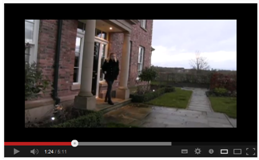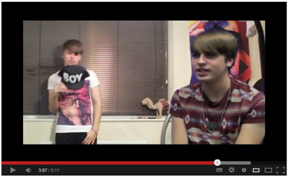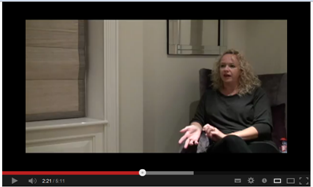A2 Media Documentary
Friday, 4 January 2013
Wednesday, 2 January 2013
Tuesday, 1 January 2013
Friday, 28 September 2012
Evaluation - Question 4 - How Did You Use Media Technologies In The Construction And Research Planning And Evaluation Stages?
To construct our documentary the main resource we used was Premiere Pro
CS5 Adobe, it took us a while to get a hang of this software but after a few
days of using it we began to understand it more.

 We also organised the background mise en scene to
We also organised the background mise en scene toreflect the topic or personality of the subject – this was most successful in Holly’s interview. Blue screen/chroma key was used to put relevant images/footage behind the subject, for example – we had footage of various magazine front covers for the background of Gemma’s interview as she was talking about the general media’s influence on young people and we used images of Chris and his merchandise behind his own interview. All of the interviews worked nicely as they all had backgrounds reflecting what they were talking about.
We also placed relevant information at the bottom of the screen during the interviews to state the person’s name, age and who they were. We also created a few montages to resemble some of the characters, for example when introducing Holly we had the narrator talking about her whilst she was walking to her flashy car in front of her big house, we filmed this from lots of different angles and added up-beat music to make it fun. We also did a short montage of Chris holding different pieces of his merchandise to show the audience.

 During the editing process we also
used archive footage to illustrate past events and to show the audience who our
interviewees were talking about, for example, the images of Kate Moss snorting
cocaine and the image of Rihanna after the abuse by Chris Brown. Using
different transitions for the images to bring them into the interview nicely.
We had inserted lots of different cutaways throughout the interviews to
illustrate what our interviewees were talking about.
During the editing process we also
used archive footage to illustrate past events and to show the audience who our
interviewees were talking about, for example, the images of Kate Moss snorting
cocaine and the image of Rihanna after the abuse by Chris Brown. Using
different transitions for the images to bring them into the interview nicely.
We had inserted lots of different cutaways throughout the interviews to
illustrate what our interviewees were talking about. The camera we used throughout the making of the documentary was a Sony HXR, MC2000E; Solid State Camera with inbuilt hard drive and USB device, these cameras had headphones so we could hear everything we were recording so we knew exactly how it would sound for somebody else watching. The camera had a screen which showed how the frame would look on the computer which made it easy for us to get the right angles and positions, we interviewed people important to the subject using these cameras with a tripod to make the camera steady, we did not feature the interviewer and the questions asked by the interviewer were edited out, the interviewee always looked across the camera at the interviewer, not at the camera, this makes it an interview not a broadcast/statement. We lit the interviewee’s face from the front not from behind so we had a clear view of their face.
All of our interviews were filmed using
different shot sizes and framing, this provided variety, we used a wide shot
for Holly’s interview, medium shots for Jen’s and Gemma’s interviews etc.

We used establishing shots to identify locations of where we were and where people lived for example during Holly’s montage of her walking to the car we used an establishing shot to show off her big house.
For the voiceover narration, we used the Sony HXR camera to record him reading a carefully written script of which anchors the meanings of the visual images and archive footage and guides the viewers understanding of the topic. Our narrator uses an authoritative voice. We used some non-diegetic musical soundtracks behind the voice over, raising the volume when there is no voice-over narration/talking.
The computer we used was a Dell XPS machine with I7 processes.
We used Photoshop CS5 Adobe to create our poster.
Our main source we used from the internet for our media product and research planning were Google for general image/information searches and archive footage.

 We also used
YouTube for archive footage and to also see what other people thought about
celebrity role models, we used videos such as ‘worst celebrity role model’ and
‘good celebrities gone bad’.
We also used
YouTube for archive footage and to also see what other people thought about
celebrity role models, we used videos such as ‘worst celebrity role model’ and
‘good celebrities gone bad’.
We also used the internet for Facebook
to share our documentary with some friends and family to see what their views
were.
 Blogger was our main used source
throughout the coursework as this is where we updated and kept all of our work.
We created a blog and had different headings that made up the full coursework.
The headings were; Documentary Analysis x6, Brainstorming- Ideas for
Documentary, Initial Plans, Target Audience Research, Brainstorm Content for
Documentary, Formal Proposal for Documentary, Research for Documentary, Running
Order, Planning, Construction, Filming, Editing Decision List, Editing,
Scripting Voiceover, Voiceover Recording, Codes and Conventions of Radio
Trailers, Scripting Radio Trailer, Recording and Editing Radio Trailer, Codes
and Conventions of Newspaper Advertisements, Drafting Newspaper Advertisements,
Newspaper Advertisement Production, Audience Feedback and Evaluation.
Blogger was our main used source
throughout the coursework as this is where we updated and kept all of our work.
We created a blog and had different headings that made up the full coursework.
The headings were; Documentary Analysis x6, Brainstorming- Ideas for
Documentary, Initial Plans, Target Audience Research, Brainstorm Content for
Documentary, Formal Proposal for Documentary, Research for Documentary, Running
Order, Planning, Construction, Filming, Editing Decision List, Editing,
Scripting Voiceover, Voiceover Recording, Codes and Conventions of Radio
Trailers, Scripting Radio Trailer, Recording and Editing Radio Trailer, Codes
and Conventions of Newspaper Advertisements, Drafting Newspaper Advertisements,
Newspaper Advertisement Production, Audience Feedback and Evaluation. Thursday, 27 September 2012
Evaluation - Question 3 - What Have You Learnt From Your Audience Feedback?
This is the first part of my audience feedback. 3 minutes 26 seconds.
This is the second part of my audience feedback. 1 minute 45 seconds.
This is the third part of my audience feedback. 1 minute 54 seconds.
Total time : 6 minutes 25 seconds
Wednesday, 26 September 2012
Evaluation - Question 2 - How Effective is the Combination of Your Media Product and Ancillary Texts (Poster and Radio Ad)? -
question 2 - this is the link for my powerpoint presentation.
<iframe src="http://www.slideshare.net/slideshow/embed_code/15931415" width="427" height="356" frameborder="0" marginwidth="0" marginheight="0" scrolling="no" style="border:1px solid #CCC;border-width:1px 1px 0;margin-bottom:5px" allowfullscreen webkitallowfullscreen mozallowfullscreen> </iframe> <div style="margin-bottom:5px"> <strong> <a href="http://www.slideshare.net/kristina1995/media-question-2-powerpoint" title="Media question 2 powerpoint" target="_blank">Media question 2 powerpoint</a> </strong> from <strong><a href="http://www.slideshare.net/kristina1995" target="_blank">kristina1995</a></strong> </div>
<iframe src="http://www.slideshare.net/slideshow/embed_code/15931415" width="427" height="356" frameborder="0" marginwidth="0" marginheight="0" scrolling="no" style="border:1px solid #CCC;border-width:1px 1px 0;margin-bottom:5px" allowfullscreen webkitallowfullscreen mozallowfullscreen> </iframe> <div style="margin-bottom:5px"> <strong> <a href="http://www.slideshare.net/kristina1995/media-question-2-powerpoint" title="Media question 2 powerpoint" target="_blank">Media question 2 powerpoint</a> </strong> from <strong><a href="http://www.slideshare.net/kristina1995" target="_blank">kristina1995</a></strong> </div>
Tuesday, 25 September 2012
Evaluation - Question 1 - In What Ways Does Your Media Product Use/Develop/Challenge the Forms and Conventions of Real Media Products?
In what ways does your media product use/develop/challenge forms and conventions of real media products?
I am firstly going to talk about the way our interviews were structured and portrayed within the documentary. Throughout the documentary we filmed and used five different interviews, all of which had different settings, people and focuses.


In this part of the interview we decided to put multiple flashing images of Chris with his merchandise in the background as this is what he is talking about. This shows the audience the merchandise he has as well as Chris talking about the merchandise.

Overall I think Chris’ interview went well, we spent the most time on this interview as it took a lot to edit, put in the background on the blue screen and alternating different images to support what Chris was talking about. After we had finished we thought we had structured the interview well including the conventions of real media products such as the rule of thirds and having different images using a variation of transitions to emphasis and support what the interviewee is talking about.
 For holly’s interview, rather than using the blue screen, we set up the room to cater for who her role model was and the types of things she was talking about, so because Holly was talking about the rich and glamorous Sarah Jessica Parker, we filmed her interview in a posh, clean and glamorous room. Therefore there was not as much editing to do on this interview as there was to do on the others.
For holly’s interview, rather than using the blue screen, we set up the room to cater for who her role model was and the types of things she was talking about, so because Holly was talking about the rich and glamorous Sarah Jessica Parker, we filmed her interview in a posh, clean and glamorous room. Therefore there was not as much editing to do on this interview as there was to do on the others. We also have an image to support what holly is talking about whilst she is still speaking, this image dissolves in and out over 2 seconds.
Holly’s interview, in my opinion was the best in terms of the set up, the mise en scene and the style of the interview itself as it matched who she is and what she was talking about, therefore it is easier for the audience to grasp the kind of person she is and also helps them understand the way she lives her life.

For the psychologist’s (Gemma’s) interview, of which we filmed in the blue screen room, we thought this was not the best decision as we were unsure as to what to use as the background because she focuses on generic points to do with young people having role models, and doesn’t have a definitive subject view, like the other interviews had.
So we decided to use the general media for the background, filming lots of different magazines to put behind Gemma, once we had done this, we realised it didn’t look to bad and actually suited with what Gemma was talking about.
Gemma talks about how young people need somebody to look up to, to guide them, and how we live in a competitive society in terms of things being shown in magazines and on the television of which is influencing children.
 For Jen’s interview we wanted to set up the mise en scene in a way that made it look formal and sophisticated as she is a concerned parent. Therefore we had her sit on an armchair, using rule of thirds, talking to the left of the camera, making sure she was eye-level with the camera but looking at the interviewer. This worked very well as it turned out to be a very formal interview. Here, are the images we used to support Jen’s views.
For Jen’s interview we wanted to set up the mise en scene in a way that made it look formal and sophisticated as she is a concerned parent. Therefore we had her sit on an armchair, using rule of thirds, talking to the left of the camera, making sure she was eye-level with the camera but looking at the interviewer. This worked very well as it turned out to be a very formal interview. Here, are the images we used to support Jen’s views.Jen talks about how Kate Moss is a bad role model for young people, we took this opportunity to include some footage of Kate Moss and the bad things that she actually did, as Jen does not go into full detail.
This is another image we used as Jen talks about how after Kate’s behaviour she just gets re-branded as the face of Rimmel, which is not a good message for children.
Jen also talks about Chris Brown, and how he is a bad role model for abusing his girlfriend, Rihanna. We put in a picture to give the ‘shock factor’ to the audience, to make the documentary more interesting.
 Overall, Jen’s interview went really well, and we got across the view of Jen being a concerned parent with the combined efforts of setting up the mise en scene in a professional, sophisticated way and Jen’s opinion.
Overall, Jen’s interview went really well, and we got across the view of Jen being a concerned parent with the combined efforts of setting up the mise en scene in a professional, sophisticated way and Jen’s opinion. 
All of our interviews follow the forms and conventions of real media products. We used rule of thirds and use of b-roll footage. We also included a montage during Chris’ interview as he speaks.
For our documentary we also had a voice over of which we recorded and embedded over the visual documentary, the voice-over talked about some of the role models, introduced the interviewees in a variety of ways and helped the documentary flow nicely. This voice acts as the ‘voice of god’.
In terms of filming, we created an introduction to Holly and her lifestyle. We did this by having Holly walk to her car outside her big house to show the kind of life she lived. We did this in an effective way to keep the audience wanting to watch. We filmed using plenty of different angles including establishing shot, over the shoulder shot, point of view shot and over head shot.
In conclusion, I think we did well in using, developing and challenging the forms and conventions of real media products to make our documentary look as professional as possible.
Subscribe to:
Comments (Atom)










